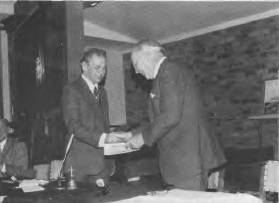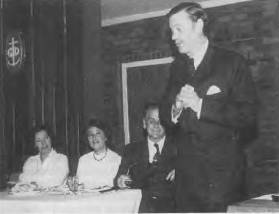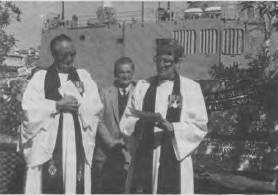- Author
- Lind, L.J.
- Subjects
- History - general
- Tags
-
- RAN Ships
- None noted.
- Publication
- December 1990 edition of the Naval Historical Review (all rights reserved)

This suggestion was adopted and in the course of the next few years some fifteen trees were planted each with a plaque commemorating a ship. Fourteen of these ships were Royal Australian navy ships but the fifteenth was a United States Navy ship. When the HMAS PERTH decided to plant their tree they received a request from USS Houston Society to plant a tree alongside.
Recently I attended the Annual Church Service of the HMAS AUSTRALIA Association and was delighted when the service was followed by a ceremony of remembrance at their tree.
Alan Payne’s last book, ‘HMAS PERTH’ was published in November. Like his previous works, ‘HMAS CANBERRA’ and ‘HMAS AUSTRALIA’ it was a well researched and presented history.
There were a number of changes in the Committee elected in 1979. President was Mr L.J. Lind; Vice Presidents Captain L.M. Hinchliffe, DSC, RAN (Ret.) and Lieutenant Commander Peter Churchill, RN (Ret.); Secretary Mr Ross Gillett, Treasurer Mr Alan Payne and Committeemen Messrs H.C. Adlam, K. Brown, R. Salmon, Lieutenant S. Hertz, ED and Mrs R. Churchill.
Two interesting days at sea were arranged early in 1980. The first, which was popular with all members but unfortunately limited in numbers, was in January. The ship was HMAS DIAMANTINA, the last of the World War 2 ships to serve in the RAN. She paid off on 20 February.
The second was in HMAS TORRENS and some fifty members participated.
Sartorial elegance
A society tie was suggested about 1975 but difficulty in having a small quantity of material woven had prevented the suggestion being implemented. However, in June, we succeeded in finding a manufacturer who would undertake the manufacture at a reasonable price. The design was conceived by Lieutenant Commander Peter Churchill and myself over lunch. It sold like wild fire and a second order was later placed. Unfortunately the blue background in the Mk.II model was too dark and to conform with fashion it was narrower and fractionally shorter.
1980

The high standard of contributions to the Naval Historical Review was maintained in 1980. To mention just one, ‘Anti-Submarine Warfare’ by member Captain Stanley Darling, OBE, DSC & 2 Bars, RANR (Ret.) was a valuable contribution to RAN Naval History. Captain Darling was one of the most successful Allied anti-submarine captains of World War 2. His greatest successes were achieved whilst commanding HMS LOCH KILLIN.
A staunch supporter of the Society from 1975 to 1982 was the Honourable Jim Killen in his capacities of Minister for the Navy and later as Minister for Defence. Mr Killen was an official guest at our first two Society dinners. Although never called upon to exercise his authority on our behalf on a number of occasions he lent spontaneous support to our projects.
Chapel – Commemorative Windows and Plaques
One of my tasks as Public Relations Officer at Garden Island was organising the completion of the series of commemorative stained glass windows in the Garden Island Chapel. The project was suggested to me by Commodore Bill Rourke who was General Manager at Garden Island at this time. My task was made much easier by Society members. The first of the World War 2 windows was the Corvettes Window which was designed, made and installed by Philip Handel. The window was officially unveiled by the Governor General and a member of the Society, Sir Zelman Cowan on 19 October, 1980. Unfortunately I was in Europe at the time and missed the ceremony.

Perhaps of equal importance to the installation of the window, this project was responsible for the formation of the RAN Corvette’s Association which is Australia’s largest naval ship association.
In the next five years I was delighted to see windows installed for the WRANS, HMAS YARRA, HMAS PERTH, SYDNEY, AUSTRALIA and the aircraft carriers. Not surprisingly all vacant windows were soon claimed. The carrier’s window was the first internal windows in the series.
This series of stained glass windows commemorating the ships of one Navy is quite unique and according to many of our visitors to the church, the finest of its kind in the world.
It was at this time we revived the practice of erecting bronze plaques commemorating distinguished officers on the walls of the chapel. This was another task which fell into my basket and one that gave me equal pleasure. The last such plaque to be erected shortly before I retired was to the late Captain Ross Blue, RAN, who wrote ‘United and Undaunted’ which was published in the Society’s series of books.
One of the more unusual activities arranged by the Society at this time was a day cruise in the commando ship KRAIT up the Hawkesbury River. A capacity party of some 100 members and their ladies joined the cruise which was arranged through the Volunteer Coastal Patrol. A highlight of the cruise was all passengers were given a spell at the ship’s wheel. During the day a survivor of KRAIT’s wartime cruise gave a dramatic account of the ship’s involvement in the commando attack on shipping in Singapore Harbour.




